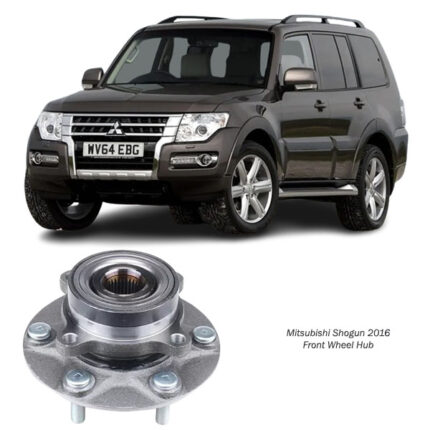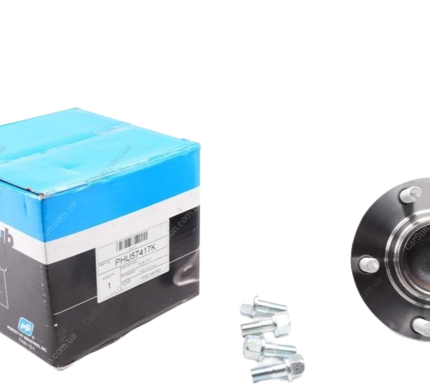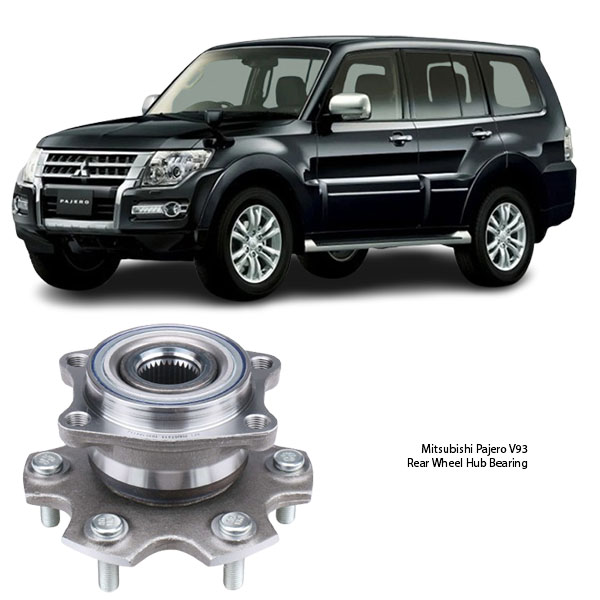-11%
Get Mitsubishi Pajero V93 / V98 Rear Wheel Hub Bearing PHU57413 in Kenya
Tucked away at the rear end of your vehicle lies a small, sturdy, and incredibly important component that many drivers rarely think about — the Rear Wheel Hub Bearing. Though it often goes unnoticed, it plays a crucial role in your vehicle’s movement, handling, and safety.
Without it, smooth driving, stable wheel rotation, and even accurate ABS function would be impossible. Let’s take a deep dive into this hardworking hero, and uncover why it deserves far more attention than it gets.
What is a Rear Wheel Hub Bearing? 🧰🔩
The rear wheel hub bearing is a part of the wheel hub assembly. It’s a precision-engineered component that enables your rear wheels to rotate freely, smoothly, and securely. It consists of a set of steel balls or rollers held together by a metal ring (called a race). These bearings sit inside the wheel hub — the mounting assembly that connects the wheel to the suspension system.
In modern vehicles, the bearing is often integrated with:
-
🧲 ABS sensors
-
🔧 Hub flange
-
🛠️ Sealed bearing units
This compact design reduces maintenance and increases durability, but when it fails, replacement is the only option.
What Does It Do? 💡🌀
Though small, the rear wheel hub bearing performs several vital functions:
-
Supports Weight ⚖️
It helps bear the load of your vehicle, including cargo and passengers. -
Enables Smooth Rotation 🔁
It allows your wheels to spin with minimal friction — essential for fuel efficiency and handling. -
Maintains Alignment 📏
A good bearing keeps your wheel aligned, avoiding uneven wear or vibration. -
ABS Integration 🚨
Many hub bearings contain magnetic encoders or tone rings that feed speed data to your ABS and traction control systems.
Without a properly functioning rear wheel bearing, safe and efficient driving becomes compromised.
How Does It Work? ⚙️
Inside the bearing, precision-ground steel balls (or rollers) roll between two metal rings. As your wheel spins, these balls roll smoothly, minimizing resistance and ensuring even weight distribution.
The entire assembly is sealed and lubricated from the factory. High-quality grease reduces heat and wear. In many modern designs, the unit is non-serviceable — if it goes bad, the entire hub and bearing must be replaced.
That’s why keeping an eye (and ear 👂) on its condition is so important.
Why the Rear Bearings Matter 🎯
People often talk more about front-end components, but rear wheel hub bearings are equally vital. They directly affect:
-
🚗 Vehicle stability
-
🚘 Cornering performance
-
🛑 Braking effectiveness
-
🔉 Noise levels while driving
-
🛞 Tire wear and rotation smoothness
When rear bearings wear out, you lose control over how the vehicle reacts — especially under stress like high speeds, braking, or turning.
Common Signs of a Failing Rear Wheel Hub Bearing 🚨🧯
Bearings are designed to be tough, but they don’t last forever. Here’s how to spot the warning signs:
-
Growling or Grinding Noise 🐻🔊
A classic symptom — it increases with speed and may fade during turns. -
Humming or Whirring Sounds 🎵
A high-pitched noise that changes depending on the road or steering direction. -
Vibration at the Rear 🌀
You might feel a subtle wobble or shudder in the back of the car. -
Uneven Tire Wear 🛞⚠️
A worn bearing can affect alignment and create patchy tread wear. -
Loose or Wobbly Wheel 🚫
If the bearing is completely shot, the wheel may feel unstable. -
ABS Warning Light 🚨
If the bearing’s sensor is damaged or corroded, the ABS system may fail.
If you experience any of these issues, it’s wise to have your suspension inspected promptly. A worn bearing can cause serious damage or even wheel detachment in extreme cases.
What Causes Bearing Wear? ⛔
While bearings are built for endurance, certain conditions can lead to premature failure:
-
🌧️ Water contamination – causes corrosion and grease breakdown
-
🛠️ Improper installation – misalignment damages internal races
-
🌫️ Debris and dirt – can enter seals and damage surfaces
-
📦 Overloading – carrying too much weight stresses the bearing
-
🚧 Rough terrain – repeated impact can dent or warp the bearing
Routine inspections and driving gently over potholes or rough roads can extend bearing life.
How is it Replaced? 🔧
Rear hub bearing replacement is a technical task, typically performed in a professional workshop. Here’s what happens:
-
🛞 Vehicle is lifted and rear wheels removed
-
🔩 Brake caliper, rotor, and sometimes the axle nut are taken off
-
🧰 Old hub assembly is unbolted and removed
-
🆕 New bearing and hub are installed and torqued to spec
-
📏 ABS connections (if present) are checked or reset
-
🧪 Final inspection and road test for smooth operation
A precise installation ensures quiet performance, long life, and safe driving.
How Long Do Rear Hub Bearings Last? ⏳
Under ideal conditions, rear hub bearings can last anywhere from 100,000 to 150,000 kilometers or more. However, environmental factors, driving habits, and road conditions all play a role.
There’s no set replacement interval — they should be changed only when they’re worn or damaged.
Why You Shouldn’t Delay Replacement ⛑️
A noisy or failing bearing might seem like just a small annoyance, but it can quickly turn into a major safety issue. Here’s what can happen if left unchecked:
-
❌ Wheel lockup or detachment
-
❌ Tire blowouts from misalignment
-
❌ ABS malfunction
-
❌ Loss of vehicle control
-
❌ Increased fuel consumption
It’s always smarter — and safer — to replace early than wait for a breakdown.
Final Thoughts 💭🔚
Though it’s small in size, the Rear Wheel Hub Bearing has a mighty impact on your vehicle’s safety, comfort, and performance. It quietly keeps your wheels spinning true, your tires wearing evenly, and your drive smooth and stable.
🔧 Regular maintenance and early diagnosis are key to preventing expensive repairs and ensuring peace of mind on every journey. If your vehicle feels or sounds different at the back — it’s time to get your rear hub bearings checked. 🛠️✅
Whether you’re commuting daily, taking weekend drives, or carrying heavy loads, trust this hardworking component to keep your wheels rolling — quietly, confidently, and safely.
Follow us on Facebook for more parts.



